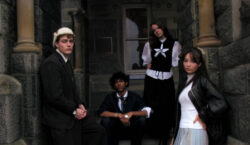Walking through the Govinda Gallery’s current exhibition, Rolling Stones 40×20, you immediately begin to wonder what you’re not seeing. Of course, there’s a picture of Keith Richards snorting coke at Joshua Tree National Park, prints from the wine-soaked debauchery of the Beggar’s Banquet album shoot and countless images of Mick Jagger in various states of intoxication and subsequent hangover.
But then you read what McCall’s photographer Art Kane said about ol’ rubber lips: “Photographing Mick Jagger, I realized that photography isn’t merely an act of selection, but is equally an act of rejection, deciding what you won’t allow in.” One can only imagine what didn’t make the cut.
Perhaps not allowing certain photographs into this small exhibition is a good idea, because there’s not one bad image in the gallery. Every photograph, from those of the wide-eyed moptops of the early ‘60s to the leathery—faced portraits of the Voodoo Lounge era, seems to capture a dramatic and vital moment in the history of the self-proclaimed “greatest rock band in the world.” Whether or not those moments are indeed seminal or simply routine, these 20 photographers have managed to bring a magnifying importance to them, creating an altogether engaging exhibit.
Take Gus Coral’s black and white photos from 1963: He captures the band in early form, before the riches, drugs and women, wearing their uniform of ties, suits and longish Beatles hair. These aren’t the stadium-rocking Rolling Stones fans have become used too, but rather the band in a simpler day, when Brian Jones and Bill Wyman were still on stage with Mick, Keith and Charlie Watts. Coral encapsulates this simpler era with his shot of the quintet on a London street, trying to scrape together enough change for a simple cab ride.
Gered Mankowitz picks up the story soon after, touring with the band “right when they got the cars and the houses.” Their hair is a bit longer, and Mick’s newfound swagger is immediately apparent in his smug poses. In one of his more famous shots, Mankowitz shows the strutting Jagger onstage during the Stones’ first American tour, emerging from the rest of the band as a rock superstar rather than just a singer?and so Mick’s notorious stage presence was born.
The intimate portraits of the exhibition, while mainly close-ups of Mick and Keith, help create a dramatic remembrance of the band. Those of Brian Jones, the former guitarist and founding member of the band who died in his own swimming pool under questionable circumstances in 1969, are especially moving. Jones’ troubled life comes through in the photography of the exhibit, in which he often seems separate and alone. Jan Oloffson’s image of Jones intently playing the sitar at Wembley in 1966 depicts this disconnected essence. In other pictures, Jones quietly disappears behind the famous extravagance of Jagger and Richards. Like common notions of the band today, the exhibit portrays Jones as a relic of the past, a distant reminder of the Stones’ long-departed youth.
Rolling Stones 40×20 continues through the ‘70s with images of Mick with Bob Marley in New York, Mick with Andy Warhol at the Love You Live release party and Mick in various rib-revealing tank tops. Dick Waterman’s black and whites from the early 1970s are perhaps the most artistically appealing works of the exhibition, featuring beautiful use of light and depth of field that make even underappreciated guitarist Mick Taylor look dramatic in all his frizzy-haired glory.
Kate Simon’s sweaty, alcohol-soaked color images from the late ‘70s hint at the coming of what Wayne “Wayne’s World” Campbell would likely call the “carbohydrate-sequined-jumpsuit-young-girls-in-white-cotton-panties-waking-up-in-a-pool-of-your-own-vomit-bloated-purple-dead-on-a-toilet phase,” and the exhibition then essentially bypasses the 1980s, which is probably a good thing.
But as 40×20 enters the 1990s, it becomes ever more focused on Keith, Mick and their cigarettes, although there are occasional glimpses of always-reserved Charlie and newest band member Ron Wood. And just as the photographs begin to show the age and wear of the band, suggesting that perhaps their days are numbered, Fernando Aceves’s spectacular black and white image of the band jamming in the shadowy basement of a 17th century Mexico City church?a reminder that the power and influence of the Stones will outlive us all.
Keith Richards once told Rolling Stone that being photographed over and over again was “fucking boring.” Perhaps, but despite what Keith thought about sitting for pictures, the results of the 40 years of photography shown in this exhibition aren’t boring in the least.
Rolling Stones 40×20 is showing until Oct. 26 at the Govinda Gallery, 1224 34th St., N.W. Admission is free.




